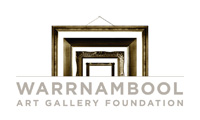History
On July 28th 1886 the Warrnambool Museum and Art Gallery was founded by a group of philanthropic citizens who saw a need to improve the town’s social climate. Originally located at the Warrnambool Mechanics Institute in Liebig Street, the Museum and Art Gallery presented a mixed assortment of artefacts. In 1888 the Gallery secured a government grant of £400. George Folingsby of the National Gallery of Victoria selected nine paintings by European artists from the Centennial International Exhibition held in Melbourne in 1888. Securing a bank loan enabled the Mechanics Institute vice-president, George Lance and Folingsby to purchase a further seven paintings.
Louis Buvelot’s painting Sunset, Waterpool at Coleraine was purchased in 1889 and in 1890 several more works were added as well as extensions to the Gallery building. The economic depression of the 1890s brought expansion of the Collection to an abrupt halt.
In 1910 the Museum and Art Gallery became a municipal institution of Warrnambool Town Council and from this time until the early 1960s the Collection remained open to the public, though collection of new paintings was on an ad hoc basis. In 1963 the Museum and Art Gallery was closed to allow for the expansion of municipal offices. The museum has never been re-opened and the remnants of its Collection are now held in storage. The art collection fared better. Six paintings were lent to other Victorian regional art galleries. During 1968 fifty five paintings from the former gallery returned temporarily to Warrnambool for an exhibition in the Town Hall to celebrate the golden jubilee of the proclamation of the city.
Following the purchase by Council of the former Bank of Australasia building on the corner of Kepler and Timor Streets, the Warrnambool Art Gallery was reopened on 5th December, 1971. From the mid 1970s the Gallery’s Collection expanded at an unprecedented rate, aided by government and council grants, corporate sponsorship, notably Fletcher Jones and Staff, Caltex Oil and The Utah Foundation, artists, public donations and the work of support groups, namely the Gallery Society, Gallery Goers and later the Friends of the Gallery. Acquisitions became focussed in the areas of colonial painting, Australian printmaking and Melbourne modernist art from 1930s to 1950s.
By 1980 the Gallery had outgrown the old bank premises and plans were made for the building of a new facility. With funds provided by the Victorian Ministry for the Arts, a purpose-built $1.25 million gallery located in Liebig Street was opened in October, 1986.
‘First opened in 1886, re-opened in 1971 and now relocated to a new building in the civic precinct opposite its original location, the Warrnambool Art Gallery is both very old and very young. With a fine collection of nineteenth century French and German European paintings, pictures and a developing collection of work by Western District artists and recent acquisitions of contemporary art practice, its holdings are of both international and local significance. With specialist surveys of colonial painting and recent contemporary Australian printmaking, its strengths are both historical and contemporary.’
Further Reading
The Warrnambool Art Gallery (1886 – 1986) by David Hansen.


